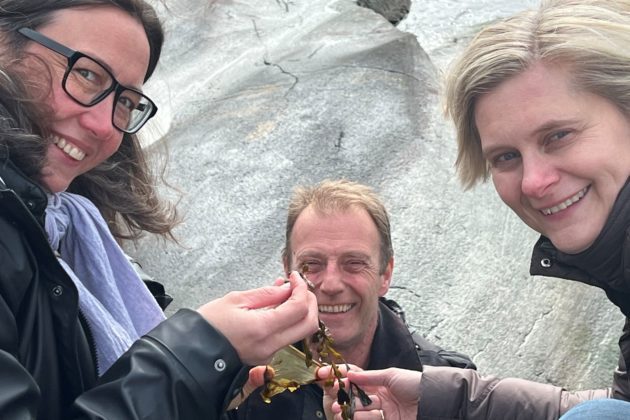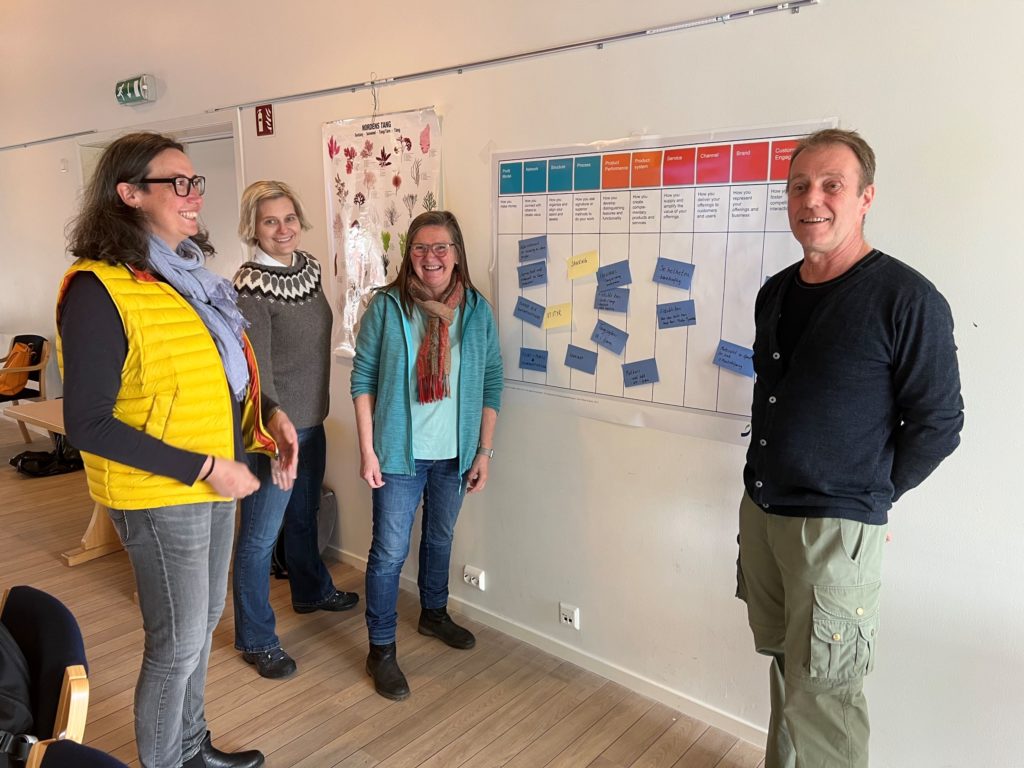Knowledge of seaweed and kelp as a success factor

It is 20 metres from the back door to the water’s edge, where bladder wrack, Norwegian kelp, sugar kelp, and Irish moss grow. It is their fascination with seaweed and kelp that prompted Anne-Lise and Bjørn Viken to take the leap from secure jobs to an entrepreneurial life. Now they have transformed their own knowledge into a sought-after product.
It all started six years ago. “We had become hooked on seaweed and kelp and knew that this was what we wanted to work with. The driving force was that seaweed and kelp are an underutilised yet sustainable resource, and that we are at the forefront of the development,” says Anne-Lise.
They envisioned developing foods, but were reluctant to take on the major investments and all the regulations tied to the approval of new food products. Now they make a living offering courses for both the civil service, private individuals and companies that are seeking knowledge about the opportunities of seaweed.
From pickled seaweed to seaweed safari
Anne-Lise and Bjørn were still in the planning phase when they participated in an innovation day in the autumn of 2016. The workshop was run by Senior Scientist Antje Gonera and Senior Adviser Stine Alm Hersleth. Among other things, it covered the Doblin Model, and it proved to be a turning point for the two entrepreneurs. It sparked a series of thoughts.
“We went from pondering which seaweed and kelp food products we should develop and produce to realising that the knowledge we were already sitting on was our strongest card, and that it was this that would give us a competitive advantage in several parts of the value chain. Our core business is the communication of knowledge about seaweed and kelp, and we’ve developed a viable concept on that basis,” says Bjørn Viken.
Anne-Lise and Bjørn established the company Ting med Tang, with a course kitchen and premises in Engelsviken, just outside Fredrikstad. The company’s main product is the “Seaweed Safari”. Over the course of a day, participants gain both theoretical and practical knowledge. They gather seaweed and kelp along the shore and learn how to clean it and how to prepare seaweed and kelp dishes, which they all eat together at the end of the day.
Innovation knowledge in practice
“The aim of the workshop was to introduce companies to innovation and how an innovation mindset can get companies out of their comfort zone and help them dare to think new and differently,” says Stine Alm Hersleth, Senior Advisor at Nofima.
She and her Nofima colleague, Senior Scientist Antje Gonera, conducted several practical exercises, including the use of the Doblin Model “Ten Types of Innovation”. The model shows that the opportunities for innovation are far broader than one might imagine, and that innovations can take place in many dimensions, such as networks, core processes, products and product systems, services and customer experiences.
Anne-Lise and Bjørn realised that knowledge delivery could be their product, and learned that the more innovation dimensions they use, the more difficult it will be for others to copy them. Thus, the idea of the Seaweed Safari was born. The goal is to create value for their customers.

The participants range from civil servants and schools to private individuals and companies, chefs and marine biologists
“We believe that seaweed and kelp have a natural place in the green shift. For example, kelp is now being tested for use in 3D-printing skin. There are currently about 22 Norwegian cultivation licenses. We see a new industry developing, but things take time,” says Anne-Lise.
Anne-Lise and Bjørn are experiencing great and growing interest in the knowledge they deliver. Seaweed and kelp are a locally sourced food that can be sustainably foraged from nature. Their customer list includes businesses of every size, organisations, museums, municipalities, and schools, as well as groups and private individuals.
The vision is to transform the mysteries of the shoreline into delicious everyday food.
“We offer Seaweed Safaris both based at our own course facilities or by travelling to our customers. We also share our knowledge and experiences on our website, https://tingmedtang.no, as well as via social media. The internet is an important channel for attracting new customers and keeping in touch with both customers and partners. Many of our customers are loyal and recommend us to others,” says Bjørn.
Teaching what’s important to know
There are several factors that are important to take into account when eating seaweed and kelp. Anne-Lise and Bjørn start the Seaweed Safari by explaining both why people should eat seaweed and kelp and why they must not eat too much.
“Seaweed and kelp can be an ingredient that adds flavor, both salt and umami, to foods. Seaweed and kelp contain loads of minerals and vitamins. Nutritionally, it is important not to consume too much iodine, and different types of seaweed and kelp contain different amounts of iodine. Kelp, in particular, can contain a lot of iodine. It’s great to replace salt with dried and crushed seaweed and kelp; they’re healthier than regular table salt. They’re also sustainable and can be found all along the coast,” Anne-Lise points out.
Participants also learn where, what and how to forage. One should only pick seaweed and kelp in places where there is throughput. The tides are important. Pick what sticks. Cut it off, don’t pull because then you will ruin the holdfasts.
About the Doblin Model
Keely et al. (2013) described the Doblin Model used in the Doblin worldwide consulting agency. The Doblin Model divides innovations into three categories with a total of ten different innovation dimensions: “Ten types of innovation”:
1. Business configuration, which focuses on the internal conditions of the enterprise (profit model, network, structure, processes and methods)
2. Market offerings that are products and services offered by the company (product differentiation and product systems)
3. Customer experience, which focuses on external issues (services, channels, brand and customer experience)

The more innovation dimensions that are integrated into an innovation, the more difficult it will be for competitors to copy the innovation. Innovations composed of several dimensions also tend to yield better returns over time.
Source:
Keely, L., Pikkel R., Quinn B. and Walters H., (2013). Ten Types of Innovation: The discipline of building breakthroughs. New Jersey: John Wiley & Sons, Inc.

